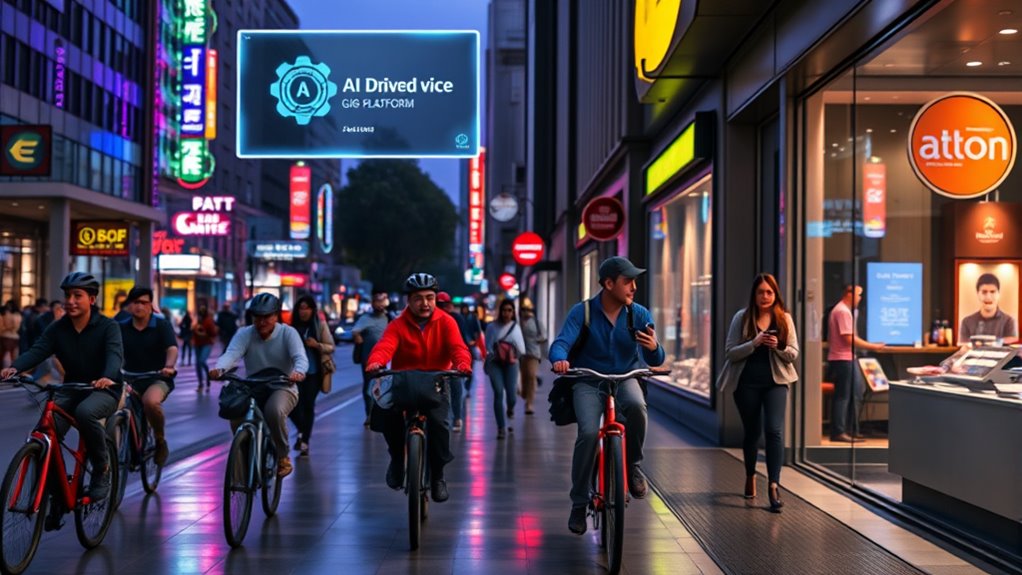Gig work can’t fully prevent unemployment from automation because it offers limited stability, benefits, and income security. While it provides flexibility and short-term income, many gig roles are low-skill with fluctuating earnings and little protection. Automation mainly impacts routine jobs, leaving complex roles more intact. If you want to understand the broader picture and the challenges workers face, there’s more to take into account beyond just gig work.
Key Takeaways
- Gig work offers flexibility but generally lacks stability and benefits, limiting its ability to fully replace traditional employment.
- Automation primarily displaces routine tasks, affecting some gig roles but leaving complex jobs less vulnerable.
- The gig economy’s rapid growth cannot counteract widespread automation-driven unemployment in many sectors.
- Gig work often provides modest income with high volatility, making it insufficient as a long-term unemployment solution.
- A comprehensive approach, including policy, retraining, and technological adaptation, is essential beyond gig work to address automation unemployment.
The Rise of the Gig Economy and Its Growth Projections

The gig economy has experienced explosive growth in recent years, transforming the way people work worldwide. By 2025, over 35% of the U.S. workforce are gig workers, with projections reaching 50% within five years. Globally, about 1.1 billion people participate in gig work, driven by platforms like Uber, DoorDash, and freelance sites. In the U.S., roughly 36% of workers are engaged in gig roles, while Europe sees around 30%, mostly in delivery and freelancing. Asia, especially India and Southeast Asia, shows rapid growth due to e-commerce expansion. The market’s value hit $455 billion in 2025 and is expected to surpass $600 billion by 2030. The gig economy’s growth rate of 17.4% annually outpaces traditional employment, making it a major sector in the global economy.
Automation’s Impact on Employment: Reality and Limitations

You might think automation is causing widespread job loss, but the reality is more nuanced; only about 14% of workers have experienced displacement so far. While some roles are shrinking, automation also shifts tasks and creates new opportunities, especially in tech and oversight. However, its limitations mean that jobs requiring complex decision-making, emotional intelligence, or creativity remain less vulnerable to automation’s reach. Current impact shows 14% of workers have experienced job loss due to automation or AI (Socius data).
Job Loss Patterns
While concerns about widespread job losses due to automation persist, current data shows that displacement is more concentrated in specific sectors and roles rather than affecting the entire workforce. About 14% of workers have already experienced job displacement from AI and automation, mostly in routine or transactional roles. In May 2023, AI caused around 3,900 job losses in the U.S., making it the seventh-largest cause of displacement. Sectors like technology, customer support, data entry, and legal services face notable layoffs, with British Telecom planning to cut 10,000 jobs over seven years. Jobs involving complex judgment, such as financial advising, are less affected and may even grow. Overall, disruptions are focused on roles with highly repetitive tasks, leaving many other occupations relatively stable. Despite the rapid advancements in AI capabilities, the pace of job displacement remains uneven across industries and job types. Additionally, automation’s impact on employment varies significantly depending on the adaptability of specific jobs and sectors. As the types of tasks that automation can handle continue to expand, some roles may experience increased displacement, but others will evolve or expand, highlighting the importance of adaptability and continuous skill development.
Automation’s Limitations
Automation cannot fully replace human judgment, especially in roles that demand emotional intelligence, creativity, and nuanced decision-making. Tasks like client negotiations, ethical choices, and strategic planning resist automation because they require understanding context and empathy. Jobs involving interpersonal skills, such as customer service or stakeholder management, are less vulnerable to AI replacement. Automation mainly targets routine, repetitive, and data-heavy tasks, leaving complex, non-routine jobs more intact. Tasks needing adaptability to new situations remain beyond current automation capabilities. Additionally, productivity gains from automation often lead to business growth and new roles rather than job losses. When AI complements human skills, workers become more efficient and satisfied. Furthermore, only about 12.6% of U.S. jobs face high or very high automation risk, indicating the limited scope of automation displacement. It is also worth noting that the human element remains irreplaceable in many sectors, emphasizing the importance of skills that machines cannot replicate. For example, emotional intelligence plays a critical role in many professions that require understanding and responding to human emotions, which current automation cannot adequately mimic. The development of specialized skills that leverage human-centered abilities further underscores automation’s limited reach. This highlights the limitations of automation in handling complex social interactions. Moreover, ongoing research into AI vulnerabilities reveals that AI systems can still be manipulated or produce biased outputs, which underscores the importance of human oversight. Overall, automation’s limitations mean it’s unlikely to fully displace jobs requiring social, creative, or complex cognitive abilities.
Shifting Workforce Dynamics
Automation has markedly reshaped the workplace by displacing some workers and transforming how businesses operate, yet its impact remains complex and nuanced. About 14% of workers have experienced job displacement due to automation or AI, with AI accounting for 5% of all job losses in May 2023. The tech sector alone saw over 136,000 layoffs this year. While automation replaces certain roles, others are growing—like personal financial advisors, projected to increase by 17.1%. Conversely, roles such as medical transcriptionists and customer service reps are declining by nearly 5%. Technological advancements, including AI, robotics, and digital access, will continue to reshape industries by 2030. Businesses are adapting through digital skills training and automation strategies, but workforce transformation remains ongoing, creating both opportunities and challenges. Automation adoption rates are increasing across various business functions, which will influence employment patterns further.
How AI-Driven Platforms Are Shaping Gig Opportunities

AI-driven platforms are transforming gig opportunities by connecting workers with suitable jobs more efficiently than ever before. They match you based on your skills, availability, and location, streamlining the hiring process and reducing administrative tasks. These platforms offer personalized job recommendations and career pathways, making it easier to find roles that fit your expertise. With 24/7 global reach, tasks can be completed anytime, anywhere. AI handles posting, matching, and quality control, freeing you from time-consuming admin work. This technology also enables highly skilled roles in IT, finance, and healthcare, giving you access to specialized projects. Micro-gig economies further break down complex tasks into small, manageable units, expanding opportunities for remote work and flexible schedules. Overall, AI-driven platforms make gig work more scalable, efficient, and tailored to your skills. As of 2023, the gig economy continues to expand rapidly, driven by technological innovations and shifting workforce expectations. Additionally, the integration of automation in job matching enhances the precision and speed of connecting workers with relevant opportunities. This rapid evolution underscores the importance of understanding how AI impacts employment and worker security. Advances in data analytics enable platforms to better understand market trends and worker performance, further refining matching accuracy. Recognizing the types of gig work available can help workers better navigate emerging opportunities in this evolving landscape. Moreover, Natural Language Processing (NLP) significantly improves customer support and engagement within gig platforms, leading to better worker and client experiences.
The Autonomy and Flexibility Offered by Gig Work

Many gig workers choose this path primarily because of the autonomy and flexibility it offers, allowing you to tailor your work to fit your personal life. You can decide your hours, work location, and methods, giving you control over your schedule. Working on multiple platforms reduces dependence on a single employer, boosting your independence. This autonomy enhances your sense of self-determination and fuels your creativity, often surpassing traditional work environments. Flexibility helps you balance work and personal responsibilities, whether it’s managing family, hobbies, or other commitments. You can choose remote or in-person work and set your own hours, creating a more adaptable career. Overall, this flexibility contributes to higher well-being and lower stress, making gig work appealing for those seeking control and personal fulfillment. Gig jobs increased by 33% in 2020 and projected to grow 17% in 2023, demonstrating the expanding availability and appeal of flexible work options. Additionally, the AI-driven tools in gig platforms can help optimize your workflow and improve productivity, further enhancing the benefits of this flexible work model. Moreover, the personal agency associated with gig work fosters a sense of empowerment that can mitigate the fears of automation displacement. Recognizing the importance of mind-body connection in adapting to change can also support gig workers in managing stress and maintaining resilience amidst evolving job landscapes. Incorporating digital skills into your gig work can further boost your adaptability and marketability in a rapidly changing employment environment. Developing predictive modeling skills may help you anticipate market trends and adjust your offerings proactively, increasing your competitiveness.
Challenges Faced by Gig Workers in the Current Landscape

As a gig worker, you face income fluctuations that make it hard to plan financially, often earning below minimum wage or under $50,000 annually. Without access to benefits like health insurance or retirement plans, your job security and social safety net are limited. This lack of stability and protections adds significant stress, especially amid rising living costs and platform-dependent work. Implementing dual-flush toilet systems and other water-efficient technologies can help reduce utility costs, allowing for better financial planning. Additionally, employing advanced fraud detection techniques can help protect your earnings from fraudulent activities that threaten financial stability.
Income Volatility and Stability
Income volatility poses a significant challenge for gig workers, as their earnings can change dramatically from week to week, making financial stability difficult to achieve. Low-income gig workers often see their income drop as much as 80% below their average monthly earnings, increasing the risk of unpaid bills and financial stress. This fluctuation is especially severe for the lowest income groups, who face larger and more frequent income dips. The unpredictability also harms health, with many gig workers experiencing sleep problems, headaches, and digestive issues linked to pay volatility. To cope, you might adjust spending, seek extra gigs, or rely on limited savings, but these strategies often fall short. Persistent income swings make it hard to plan for the future or achieve financial security.
Lack of Benefits and Protections
Gig workers face significant hurdles because they lack access to traditional benefits and protections that safeguard employees in standard jobs. Only 40% have employer-sponsored health insurance, and just 25% have dental coverage. Life insurance is even less common, with about 20% of gig workers covered. Retirement plans are rare, forcing many to manage their savings alone. Social protections are limited—most don’t qualify for unemployment benefits, and job security is uncertain. They lack rights like collective bargaining and face greater workplace safety risks without regulation. Legal protections against unfair practices are often absent. Access to training, career growth, and essential technology remains limited. These gaps highlight how gig workers are vulnerable, with few safety nets in place as the gig economy expands.
Sectoral Shifts and the Future of Work in a Automated World

Technological advancements are rapidly reshaping industries, driving significant sectoral shifts that will redefine the future workforce. You’ll see AI and information processing technologies transforming 86% of industries by 2030, changing how work gets done. Robotics and automation are impacting 58%, reducing manual and routine tasks, while innovations in energy are affecting 41%, altering traditional energy roles.
Consider these shifts:
- Roles like personal financial advising will grow 17.1%, reflecting demand for human expertise.
- Jobs such as medical transcriptionists and customer service reps will decline, with reductions of 4.7% and 5%, respectively.
- Sectors like legal, insurance, and engineering will adapt through AI, but employment impacts will vary, favoring productivity gains over large job losses.
These changes highlight a future where industries evolve, requiring workers to adapt continuously.
Can Gig Work Bridge the Gap for Displaced Workers?

Can gig work serve as an effective safety net for workers displaced by automation? It currently provides a significant fallback, with over a third of the U.S. workforce engaged in some form of gig activity, expected to reach half by 2025. After job losses, many turn to gig jobs, especially older workers, who are more likely to do so. However, gig work often offers low pay—most earn just $300 to $400 a month—and many struggle with underpayment, lack of benefits, and food or healthcare insecurity. While gig jobs can help fill employment gaps temporarily, they don’t offer stability or long-term security. So, although gig work can help displaced workers stay afloat, it’s unlikely to fully replace the stability of traditional employment or address all related hardships.

As the gig economy continues to expand, its potential to fully offset automation-related unemployment remains uncertain. While nearly 50% of the U.S. workforce may be gig workers by 2025 and global numbers reach 1.1 billion, significant limitations exist. Consider these points:
- Many gig roles, especially in low-skill areas, lack stability and benefits, making them unsuitable as long-term replacements.
- Automation continues to impact large sectors, with substantial layoffs, like BT’s 10,000 jobs cut over seven years, showing gig work can’t keep pace.
- AI-driven platforms improve efficiency but also threaten gig roles through automation, potentially replacing jobs even within the gig economy.
Frequently Asked Questions
How Sustainable Is Gig Work as a Long-Term Employment Solution?
Gig work offers flexibility and accessibility, making it appealing as a long-term employment option. You can adapt to economic shifts and benefit from digital platforms that connect you with various opportunities. However, it’s not entirely sustainable because income can be inconsistent, and benefits are often lacking. To thrive long-term, you’ll need to develop diverse skills, build a steady client base, and stay adaptable in an evolving job market.
What Skills Are Most in Demand for Gig Roles Driven by AI?
You might wonder which skills will keep you ahead in AI-driven gig roles. The answer is a mix of technical expertise—like data analysis, machine learning, and cybersecurity—and soft skills such as creativity and critical thinking. Staying digitally proficient and understanding automation technologies are essential. By continuously upskilling and adapting, you’ll not only meet demand but also turn uncertainty into opportunity in this evolving gig economy.
How Do Gig Workers Access Benefits and Job Protections?
You can access benefits and protections as a gig worker through various channels. Some platforms offer portable benefits like health insurance and retirement plans that move with you. Employers are also providing perks such as training, networking, and financial resources. Additionally, stronger labor laws and advocacy groups work to improve gig workers’ rights, while specialized platforms and legal rulings increasingly aim to secure job protections and benefits for freelance workers like you.
Can Gig Work Fully Replace Traditional Employment in Automation-Heavy Industries?
You might wonder if gig work can fully replace traditional jobs in automation-heavy industries. While gig work offers flexibility and on-demand opportunities, it can’t provide the stability, benefits, or job security most workers need. Automation reduces many routine roles, and gig platforms can’t scale to support displaced workers long-term. So, even with its growth, gig work isn’t a complete substitute for traditional employment in these sectors.
What Policies Are Needed to Support Gig Workers Amid Automation Trends?
Imagine a world where gig workers are superheroes with capes made of flexible policies. To support you amid automation trends, policies should grant benefits like healthcare and retirement, empower collective bargaining, and guarantee fair treatment. They must also promote retraining and upskilling, protect data privacy, and create flexible work arrangements. These measures will help you navigate the robotic revolution, turning digital chaos into a manageable, even enjoyable, adventure.
Conclusion
While gig work offers flexibility and new opportunities, it’s not a silver bullet for automation unemployment. You’ll face challenges like income instability and limited benefits. Remember, “don’t put all your eggs in one basket”—diversify your skills and adapt. The gig economy can help, but staying proactive and continually learning is key to weathering a future shaped by automation. It’s up to you to prepare for what’s next.









